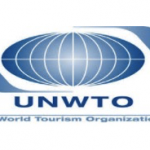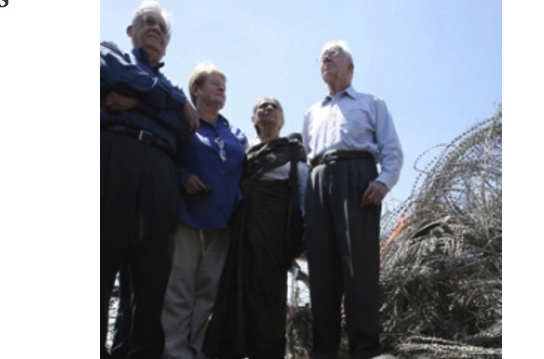. .DISARMAMENT & SECURITY. ,
An article by Uri Avnery from Transcend
The Arab taxi driver who brought me to Ramallah had no trouble with the Israeli border posts. He just evaded them.
Saves a lot of trouble.
I was invited by Mahmood Abbas, the President of the Palestinian National Authority (as well as of the PLO and the Fatah movement) to take part in joint Palestinian-Israeli consultations in advance of the international conference in Paris.

Since Binyamin Netanyahu has refused to take part in the Paris event side by side with Mahmood Abbas, the Ramallah meeting was to demonstrate that a large part of Israeli society does support the French initiative.
SIMPLE AS it sounds, the Ramallah meeting was not simple at all.
Before the death of Yasser Arafat in 2004, such meetings were almost routine. Since our groundbreaking first meeting in Beirut in 1982, during the Israeli blockade, Arafat met many Israelis.
Arafat had almost absolute moral authority, and even his home-grown rivals accepted his judgment. Since, after our first meeting, he decided that Israeli-Palestinian meetings served the cause of Palestinian-Israeli peace, he encouraged many such events.
After his murder, the opposite trend gained the upper hand. Palestinian extremists held that any meetings with Israelis, whoever they might be, served “normalization” – a terrible, terrible bogeyman.
Abbas has now put an end to this nonsense. Like me, he believes that Palestinian statehood and independence can come about only through a joint struggle of the peace forces on both sides, with the help of international forces.
In this spirit, he invited us to Ramallah, since Palestinians are not normally allowed into Israeli territory.
He seated me next to him on the stage, and so the meeting started.
MAHMOOD ABBAS – or “Abu Mazen”‘, as he is generally known – was gracious enough to mention that he and I have been friends for 34 years since we first met in Tunis, soon after the PLO had left Beirut and moved there.
Through a number of years, when my friends and I came to Tunis, the same procedure was followed: first we met with Abu Mazen, who was in charge of Israeli affairs, and drew up plans for joint action. Then we all moved to Arafat’s office. Arafat, who had an almost uncanny capacity for making quick decisions, would decide within minutes “yes” or ‘no”.
There could hardly be two more different characters than Abu-Amar (Arafat) and Abu-Mazen. Arafat was a “warm” type. He embraced and kissed his visitors in the old Arab style – a kiss on each cheek for ordinary visitors, three kisses for preferred ones. After five minutes, you felt as if you had known him all your life.
Mahmood Abbas is a much more reserved person. He embraces and kisses too, but it does not come quite as naturally as with Arafat. He is more withdrawn. He looks more like a high-school principal.
I have a lot of respect for Mahmood Abbas. He needs tremendous courage to do his job – the leader of a people under brutal military occupation, compelled to cooperate with the occupation in some matters, endeavoring to resist in others. The aim of his people is to endure and survive. He is good at that.
When I complimented him on his courage, he laughed and said that it was more courageous of me to enter Beirut during the siege of 1982. Thanks.
The Israeli government succeeded, even before Netanyahu, in splitting the Palestinians in the country into two. By the simple device of refusing to honor their solemn pledge under Oslo to create four “safe passages” between The West Bank and Gaza, they made a split almost inevitable.
(article continued in right column)
Question related to this article:
Presenting the Palestinian side of the Middle East, Is it important for a culture of peace?
How can a culture of peace be established in the Middle East?
(article continued from left column)
Now, while officially treating the moderate Abbas as a friend and the extremist Hamas in Gaza as an enemy, our government behaves exactly the other way. Hamas is tolerated, Abbas is considered an enemy. That seems perverse but is really quite logical: Abbas can sway public opinion throughout the world in favor of a Palestinian state, Hamas cannot.
AFTER THE Ramallah meeting, in a private session, I submitted to Abbas a plan for consideration.
It is based on the appreciation that Netanyahu will never agree to real peace negotiations, since these will lead inevitably to the Two-State Solution, tut-tut-tut.
I propose to convene a “Popular Peace Conference”, which will meet, say, once a month inside the country. In each session, the conference will deal with one of the paragraphs of the future peace agreement, such as the final location of the borders, the character of the borders (open?), Jerusalem, Gaza, water resources, security arrangements, refugees, and so on.
An equal number of experts and activists from each side will deliberate, put everything on the table and thrash it all out. If agreement can be reached, wonderful. If not, the proposals of both sides will be clearly defined and the item left for later.
In the end, after, say, half a year, the final “popular peace agreement” will be published, even with defined disagreements, for the guidance of the peace movements on both sides. Deliberations on the disagreements will continue until agreement is found.
Abbas listened attentively, as is his wont, and in the end I promised to send him a written memorandum. I just did so, after consulting with some of my colleagues, like Adam Keller, the Gush Shalom spokesman.
Mahmood Abbas is now preparing to attend the Paris conference, the official aim of which is to mobilize the world for the Two-State Solution.
SOMETIMES I WONDER how I do not get infected with megalomania. (Some of my friends believe that this cannot happen to me, since I already am a megalomaniac.)
A few weeks after the end of the 1948 war, a tiny group of young people in the new State of Israel met in Haifa to debate a path to peace based on what is now called the Two-State solution. One was a Jew (me), one a Muslim and one a Druze. I, just released from hospital, was still wearing my army uniform.
The group was completely ignored by everybody. No takers.
Some ten years later, when I was already a member of the Knesset (as, by the way, were the other two), I went abroad to see who could be convinced. I wandered around Washington DC, met with important people in the White House, the State Department and the UN delegations in New York. On the way home I was received in the Foreign Offices in London, Paris and Berlin.
No takers, anywhere. A Palestinian state? Nonsense. Israel must deal with Egypt, Jordan et al.
I made many dozens of speeches about this proposal in the Knesset. Some powers started to take it up. The first was the Soviet Union, though rather late, under Leonid Brezhnev (1969). Others followed.
Today there is no one around who believes in anything but the Two-State Solution. Even Netanyahu pretends to believe in it, if only the Palestinians would become Jews or emigrate to Greenland.
Yes, I know that I didn’t do it. History did it. But I might be excused for feeling just a tiny little bit of pride. Or a mini-megalomania.
THE TWO-STATE SOLUTION is neither good nor bad. It is the only.
The only solution there is.
I know that there are a number of good, even admirable people who believe in the so-called One-State Solution. I would ask them to consider the details: what it would look like, how it would actually function, the army, the police, the economy, the parliament. Apartheid? Perpetual civil war?
No. Since 1948 everything has changed, but nothing has changed.
Sorry, the Two-State Solution is still the only game in town.









